Oak Shrublands
Oak shrublands cover approximately 2 million acres in Colorado between elevations of approximately 6,000 and 9,000 feet.

These shrublands account for 10 percent of the forested lands in Colorado and are found throughout most of western Colorado, along the southern Front Range and in the central part of the state. Their appearance can range from dense thickets with little understory to relatively moist sites with a rich understory of shrubs, grasses and wildflowers.
Click on the map to view full size
Fire and Wildlife in Oak Shrublands
Fire usually plays an important role in maintaining oak shrublands; it promotes regeneration, controls the invasion of trees, and increases the density and cover of Gambel oak (Quercus gambelii) and serviceberry (CNHP 2009)1. Many of these landscapes currently suffer from altered fire regimes due to extensive fire suppression, especially in the wildland-urban interface. Wildlife species associated with oak shrublands include sharp-tailed grouse, mule deer, elk, Abert’s squirrels, black bears, blue grouse and Merriam’s turkey.
Learn More
Learn about Gambel oak management (3 MB PDF)
Text Citation
1 Colorado Natural Heritage Program. 2009. Guide to the Ecological Systems of Colorado, Key D for Oak shrubs. Available online at https://cnhp.colostate.edu/download/documents/EcolSystems/Key%20to%20Upland%20Ecological%20Systems%20of%20Colorado%202020.pdf.
Data Sources
NatureServe. 2018. International Ecological Classification Standard: Terrestrial Ecological Classifications. NatureServe Central Databases. Arlington, VA. U.S.A. Data current as of 28 August 2018.
2017 Colorado Wildfire Risk Assessment, Colorado State Forest Service.



